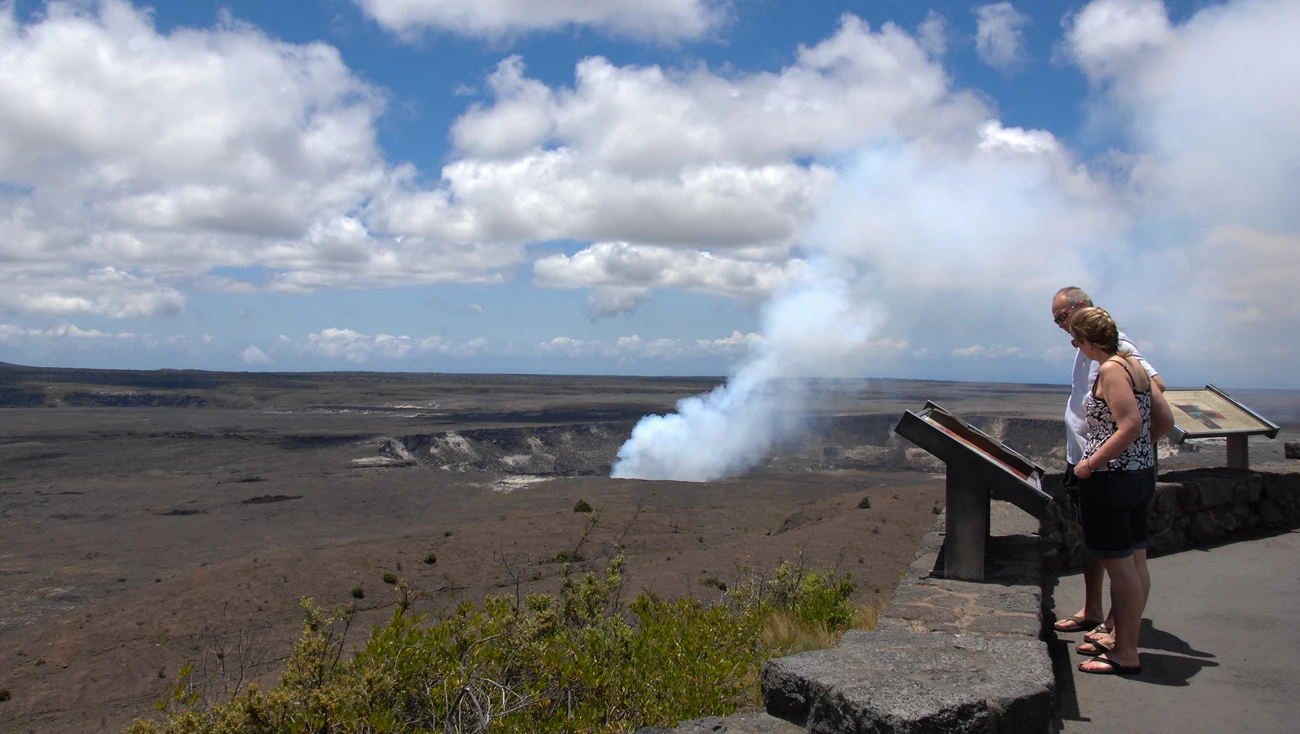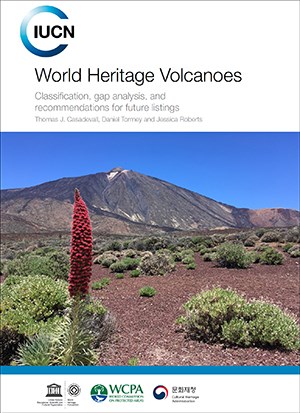
NPS photo.

International Union for Conservation of Nature (IUCN), authors: Casadevall, Thomas J.; Tormey, Daniel; and Roberts, Jessica (2019).
Introduction
Volcanic landscapes are among the most easily-recognisable and frequently-nominated natural areas of the World Heritage Convention. A World Heritage site is a place (such as a building, monument, desert, forest, cave or volcano) that is inscribed on the World Heritage List by the United Nations Educational, Scientific and Cultural Organization (UNESCO) as being of Outstanding Universal Value. Outstanding Universal Value is defined as having significance so exceptional as to transcend national boundaries and to be of common importance for present and future generations of all humanity (Casadevall et al. 2019).
Volcanoes demonstrate geological and geomorphological processes fundamental to understanding how the dynamic Earth works, from the global to the local scale and linking processes in the Earth’s interior with those on its surface. In addition to their core geoscience values, volcanoes provide one of Nature’s most dynamic stages, which has expressions in the great biodiversity found in many volcanic landscapes, the cultural connections between people and their environment, and as a record of human developments on every continent (Casadevall et al. 2019).
World Heritage Volcanoes in the United States
Use the drop-down arrows to learn more about each site.Year of Inscription: 1978
Name of volcano: Yellowstone caldera
Plate Tectonic Setting: Intraplate (Hot Spot)
Smithsonian Holocene (active) volcano 325010
Qualifying Criteria—Outstanding Universal Value (OUV):
(vii) to contain superlative natural phenomena or areas of exceptional natural beauty and aesthetic importance
(viii) to be outstanding examples representing major stages of Earth’s history, including the record of life, significant ongoing geological processes in the development of landforms, or significant geomorphic or physiographic features
(ix) to be outstanding examples representing significant ongoing ecological and biological processes in the evolution and development of terrestrial, freshwater, coastal and marine ecosystems and communities of plants and animals; and to contain the most important and significant natural habitats for in-situ conservation of biological diversity, including those containing threatened species of OUV from the point of view of science or conservation
(x) to contain the most important and significant natural habitats for in-situ conservation of biological diversity, including those containing threatened species of outstanding universal value from the point of view of science or conservation
Year of Inscription: 2010
Name of volcanoes: Volcanic islands of Hawaiian Archipelago
Plate Tectonic Setting: Intraplate (Hot Spot)
Qualifying Criteria—Outstanding Universal Value (OUV):
(iii) to bear a unique or at least exceptional testimony to a cultural tradition or to a civilization which is living or which has disappeared
(iv) to be an outstanding example of a type of building, architectural or technological ensemble or landscape which illustrates (a) significant stage(s) in human history
(viii) to be outstanding examples representing major stages of Earth’s history, including the record of life, significant ongoing geological processes in the development of landforms, or significant geomorphic or physiographic features
(ix) to be outstanding examples representing significant ongoing ecological and biological processes in the evolution and development of terrestrial, freshwater, coastal and marine ecosystems and communities of plants and animals; and to contain the most important and significant natural habitats for in-situ conservation of biological diversity, including those containing threatened species of OUV from the point of view of science or conservation
(x) to contain the most important and significant natural habitats for in-situ conservation of biological diversity, including those containing threatened species of outstanding universal value from the point of view of science or conservation
Year of Inscription: 1987
Name of volcanoes: Several volcanoes
Smithsonian Holocene (active) volcano 332010, 332020, and 332060
Plate Tectonic Setting: Intraplate (Hot Spot)
Qualifying Criteria—Outstanding Universal Value (OUV):
(viii) to be outstanding examples representing major stages of Earth’s history, including the record of life, significant ongoing geological processes in the development of landforms, or significant geomorphic or physiographic features
Year of Inscription: 1979
Name of volcanoes: Uinkaret Field and Vulcans Throne
Smithsonian Holocene (active) volcano 29010
Plate Tectonic Setting: Divergent Plates
Qualifying Criteria—Outstanding Universal Value (OUV):
(vii) to contain superlative natural phenomena or areas of exceptional natural beauty and aesthetic importance
(viii) to be outstanding examples representing major stages of Earth’s history, including the record of life, significant ongoing geological processes in the development of landforms, or significant geomorphic or physiographic features
(ix) to be outstanding examples representing significant ongoing ecological and biological processes in the evolution and development of terrestrial, freshwater, coastal and marine ecosystems and communities of plants and animals; and to contain the most important and significant natural habitats for in-situ conservation of biological diversity, including those containing threatened species of OUV from the point of view of science or conservation
(x) to contain the most important and significant natural habitats for in-situ conservation of biological diversity, including those containing threatened species of outstanding universal value from the point of view of science or conservation
Year of Inscription: 1979 (Extension in 1992 and 1994)
Name of volcano: Wrangell
Smithsonian Holocene (active) volcano 315020
Plate Tectonic Setting: Convergent Plates
Qualifying Criteria—Outstanding Universal Value (OUV):
(vii) to contain superlative natural phenomena or areas of exceptional natural beauty and aesthetic importance
(viii) to be outstanding examples representing major stages of Earth’s history, including the record of life, significant ongoing geological processes in the development of landforms, or significant geomorphic or physiographic features
(ix) to be outstanding examples representing significant ongoing ecological and biological processes in the evolution and development of terrestrial, freshwater, coastal and marine ecosystems and communities of plants and animals; and to contain the most important and significant natural habitats for in-situ conservation of biological diversity, including those containing threatened species of OUV from the point of view of science or conservation
(x) to contain the most important and significant natural habitats for in-situ conservation of biological diversity, including those containing threatened species of outstanding universal value from the point of view of science or conservation
Last updated: April 18, 2023
